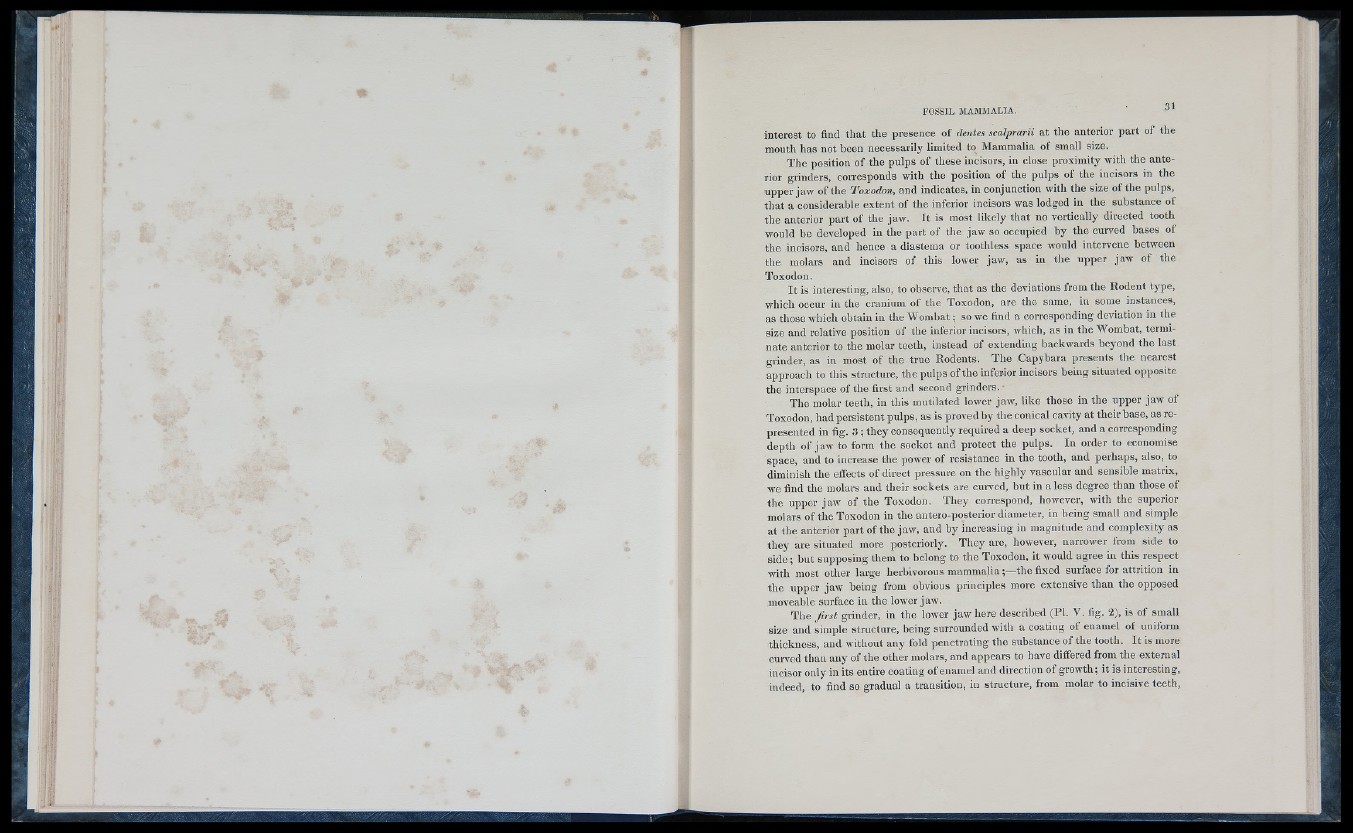
interest to find that the presence o f denies scalprarii at the anterior part o f the
mouth has not been necessarily limited to Mammalia o f small size.
The position o f the pulps o f th e se incisors, in close proximity with the anterior
grinders, corresponds with th e position o f the pulps o f the incisors in the
upper jaw o f the Toxodon, and indicates, in conjunction with the size o f the pulps,
that a considerable ex tent o f the inferior incisors was lodged in the substance o f
the anterior part o f the jaw. It is most lik e ly that no vertically directed tooth
would be developed in the part o f the jaw so occupied b y the curved bases o f
the incisors, and hence a diastema or toothless space would intervene between
the molars and incisors o f this lower jaw, a s in the upper jaw o f the
Toxodon.
I t is interesting, also, to observe, that as the deviations from the Rodent type,
which occur in the cranium o f the Toxodon, are the same, in some instances,
as those which obtain in the W om b a t; so we find a corresponding deviation in the
size and relative position o f the inferior incisors, which, as in the Wombat, terminate
anterior to the molar teeth, instead o f extending backwards beyond the la st
grinder, as in most o f the true Rodents. The Capybara presents the nearest
approach to this structure, the pulps o f the inferior incisors b ein g situated opposite
the interspace o f the first and second grinders.
Th e molar teeth, in this mutilated lower jaw, lik e those in the upper jaw o f
Toxodon, had persistent pulps, as is proved by the conical cavity at their base, as represented
in fig. 3 ; they consequently required a deep socket, and a corresponding
depth o f jaw to form the socket and protect the pulps. In order to economise
space, and to increase the power o f resistance in the tooth, and perhaps, also, to
diminish the effects o f direct pressure on the h ig lily vascular and sensible matrix,
we find the molars and their sockets are curved, hut in a le ss degree than those o f
the upper jaw o f the Toxodon. T h ey correspond, however, with the superior
molars o f the Toxodon in the antero-posterior diameter, in being small and simple
at the anterior part o f the jaw, and by increasing in magnitude and complexity as
they are situated more posteriorly. T h ey are, however, narrower from side to
s id e ; hut supposing them to belong to the Toxodon, it would agree in this respect
with most other large herbivorous m a m ma l i a t h e fixed surface for attrition in
the upper jaw being from obvious principles more ex ten siv e than the opposed
moveable surface in the lower jaw.
The f ir s t grinder, in the lower jaw here described (PI. V. fig. 2), is o f small
size and simple structure, being surrounded with a coating o f enamel o f uniform
thickness, and without any fold penetrating the substance o f the tooth. I t is more
curved than any of the other molars, and appears to have differed from the external
incisor only in its entire coating o f enamel and direction o f growth; it is interesting,
indeed, to find so gradual a transition, in structure, from molar to incisive teeth.